“Be Careful What You Buy.” Why Gold and Silver Are Good Bets Right Now - Weekly Wrap Up (May 8, 2020)
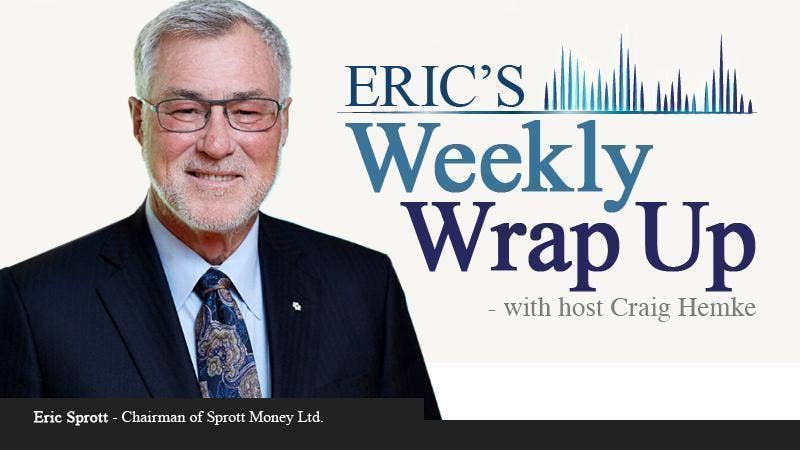
May 8, 2020
As coronavirus and containment measures continue to wreak havoc on the world economies, host Craig Hemke and Eric Sprott sit down to discuss all the gold and silver news you need to weather the storm. In this edition of the Weekly Wrap-Up, you’ll hear:
- Why silver is about to pop
- What’s behind the terrific week for the mining shares
- Plus: Are negative interest rates coming?
“First of all… I don’t trust the data that comes out from any government agency, because they’ve been so hopeless with numbers. And of course, the April jobs numbers is backward-looking information. We know exactly what’s going on with the labor market; we get weekly unemployment insurance claims. And I think it grew up to, what, in excess of 30 million? So what’s it matter what they say April was? It’s what we’re going to do going forward. I don’t think that number should have any bearing on any markets today.”
Announcer: You're listening to the Weekly Wrap Up on Sprott Money News.
Craig: Hello again, from Sprott Money News at sprottmoney.com. It's Friday, May the 8th, 2020. It's time for your weekly wrap up. I'm your host, Craig Hemke, and joining us again, this Employment Report Friday is Eric Sprott himself. Eric, good morning.
Eric: Hey, good morning, Craig. More information that we can treat as disinformation and let's try to sort it all out and see where we're going.
Craig: Let's give a run at that, my friend. Hey, and just a reminder to everybody, you know, things are all kind of upside down across the precious metals industry still, and we're all fighting through supply and logistical issues, but it is business as usual in terms of information at sprottmoney.com. One of the things we do every month is called the Ask the Expert segment. And that for this month will feature Mickey Fulp. Many of you know Mickey Fulp as The Mercenary Geologist, has a great free newsletter, and knows a heck of a lot about a lot of mining companies. And so if you want to submit a question for Mickey Fulp for the Ask the Expert segment this month, just email us at submissions, the word submissions, submissions@sprottmoney.com. Eric, let's talk a little bit about what has taken place this week. Maybe the employment report this morning, of course, being used as usual to hit prices, or maybe this notion that negative interest rates are right around the corner in the U.S. What have you seen this week?
Eric: Sure. Well, first of all, I always find... Of course, I don't trust the data that comes out from any government agency because they've been so hopeless with numbers. And of course, the April jobs numbers is backward-looking information. And we know exactly what's going on with the labor market. We get a weekly unemployment insurance claim and I think we're up to, what, in excess of $30 million. So what does it matter what they say April was, it's what we're going to do going forward. I don't think that that number should have any bearing on any markets today, but sure enough, you know, they beat up on gold for some bizarre reason. But as you and I know, gold many times has been chopped up, only to come back again. As we've seen it so many times just before the opening up, my own theory of why they beat up on gold before the opening, and that is that they just take the wind out of the sails of someone who was going to buy one of the physical ETFs, because I honestly believe there's a shortage. So we'll talk about that later. I did want to talk just briefly on the COVID-19. Again, it seems to me that the morbidity is going to be way less than what we were anticipating. Of course, the big problem was it spread so fast that it was just taxing the healthcare system. So they needed to shut it down. It'll be interesting to see when we open it up again. You know, if we don't practice social distancing and things like that, I suspect we could have a, certainly, easily another wave of things. But I do believe that the best solution is in fact to open up the economy. I just fear that the depression we're in might cause a loss of more lives and...than the virus.
So, and one other thing that we don't know is the after-effects, right? We read all sorts of things about other organs being impacted. So we still got to stand by on that one and that'll take time to figure out. Economically, when I look at the economy, you know, what is the cost of bailing everyone out? And can we afford it? That's very much an unknown. The money that's been committed by the Fed and the Treasury, is just a mind-boggling number, and we're not going to know for a while whether it will be enough. And I suspect it won't be enough because of the leverage that we had in the system. And I get the sense looking at the decisions of the bankers, they're not going to increase lending. They're increasing the lending standards. We've seen it all over the place. You know, the big banks, out of nowhere, the restrictions on mortgage, they're tighter, eLocks, we don't want to give them out anymore. And I suspect, by the way, that there's a problem in the banking industry because when I look at the charts, I think JP Morgan went from $140 to $80. And it's back to $90. Excuse me, back to $90? That's nothing. And I see it in some of the Canadian bank shares, as well. And so I suspect there is a real issue going on in the banking business. Everybody knows that most of the credits they have are at risk. And so you're not seeing this bounce back in the bank stocks, which I think is a bit of a sign of what's really going on in the world. And of course, the fact that interest rates look like they might want to go negative here and that the bond market, just the yields keep going down, we have a real dichotomy in what the bond market's trying to tell us, what the bank stocks are trying to tell us, and what the general stock market's doing.
Craig: Yeah, that's for sure. What do you think is the prospect of negative rates in the U.S.? That was a big driver of the bump in prices yesterday.
Eric: Well, there's a real battle going on in the sense that, I mean, I think that the powers that be want yields to stay low, but at the same time, we've got these huge Treasury issues that we have to deal with and, you know, unless the Fed buys, you know, an overwhelming part of the bond issues, I'm sure rates would naturally go up. But I think the Fed will step in there. So I think some elements would suggest that we could go and touch negative rates certainly in the derivative markets looking out. And of course, that might in itself suggest that, oh my goodness, there's not going to be the economic, the extent of recovery that we can imagine. And every time someone says it's getting better, well, it better get better. You know, we've got GDP down, whatever number you want to pick, 30% or 40%. It better get better. But just getting better doesn't mean that you got to go out and buy stock, because you can get better and go from minus 40% to minus 30%, well, you know, that's still a train wreck. So be careful what you want to buy into here.
Craig: Yeah, I hear you there. It has been a very good week for the miners, particularly some of the seniors that have been...that are producing and, gosh, definitely seeing their profits and their dividends increase. Anything there that has caught your eye as we've gone through the week?
Eric: Yeah, yeah, of course. And of course, the biggest thing is the GDX, GDX index, the ETF for gold stocks, senior gold stocks, I mean, in seven weeks, gone up 80%. Where do you make 80% in 7 weeks? Well, I know what happened in gold stocks. I've seen it happen so many times, it's a bit of a joke. And obviously they've technically broken out here. I still go back to the physical markets and apparently the ETS in the month of April added 170 countries in the month of April. You know how I like to annualize things. Okay. Well, that's 2000 tons. I mean, X China, X Russia, we only mined about 2300 tons a year. And the ETFs are buying at a rate of 2,000 tons. And I know I've seen some work by Goldman talking about private purchases outside of the ETFs, and I apologize for not having those numbers at the tip of my fingers, but there was some serious buying going on. So I'm of the school, that there is a serious physical shortage. I see that HSBC and the BNP Paribas both said they had a measure called the value at risk that they breached their expected value at risk, and then attributed it to delivery issues in gold. And I'm thinking, wow, how much were you guys short and owed, that you could affect your value at risk 12 times in the month of March, 12? There's only 22 trading days in March, in 12 days they exceeded their limits. And, in fact, I actually looked at the chart on HSBC, and it looks just like the other ones, there's no rally here considering the extent to which they went down.
So there's lots of indications that something is still going on, in the gold mining. Even yesterday's moving the price of gold, going up at one point $40 in closing, I think it was $34. Silver doing the big turnaround, I forget whether it was...it ended up 50 or 60 cents but it was up a lot. Trying to go up today in the face of gold going down. So there's something going on in silver. And silver is a very, very small market. I mean if the investors who want to buy 170 tons of gold in a month started putting a little bit of that money in silver, there would be such an increase in the price of silver it would be crazy. As you've been pointing out, the CalMax has almost gone comatose here with the lack of volume and the lack of change in open interest. And the deliveries are incredible. I mean, I think the deliveries for silver could be something like 50 million ounces this month. That in itself... I mean, 50 million ounces, you know, that's the $600 million annualized number, if it happened every month, which it won't for sure, but anyway. We're probably not even mining that much in a month these days with all the shutdowns that have taken place.
The technicals are both gold and silver, they both broke out of what I think the technician would call, bullish wedges. I was interested to see that you had Mr. Vermeulen on one of your podcasts. And, of course, he's very excited about where gold can go and others are chiming in, as well, suggesting gold's quickly going to go to 1800, which was what his call was about a week and a half ago. And it looks like we're headed there, notwithstanding, you know, I don't know what you want to call that job's number, knocking the price of gold down $14, but just in so many days now when gold gets knocked down, and it rallies back, so I'm hoping that will be the case today, as well. I think that's really all I have in the general gold market and happy to chat about stocks.
Craig: All right. Well, I've got... And we always invite everybody to email us questions each week and they can use that same submissions@sprottmoney.com email address to do it. And Eric, we had like 46 different questions this week. So I very much appreciate everybody sending them in. Unfortunately, we're not going to be able to get to all of them. So Eric and I have spent some time before we started recording, kind of, trying to cull the list and see if there's companies he can talk about and companies he knows anything about at all. So I can assure everyone listening, that I did ask him about, you know, companies like Redstar Gold and you know, GR Silver Mining and Endeavour Silver, things like that. And Eric just doesn't have any opinions, but I want you to know that we did see every single submission that comes in. To that end, there are some questions that just don't deal specifically with miners. I mean just more general, Eric, so I want to lay these on you and see how you feel about them. One, somebody wants to know, you know, we talk about owning precious metals outside of the banking system, how important that is, but you know, a lot of folks own a PHYS, PSLV, things like that, the CEF, they own them, you know, kind of in the banking system, in their brokerage account, how do you feel about that? This person wants to know if that's a safe thing to do.
Eric: Yeah. Well, you know, when you leave assets at a bank, they can be considered the bank's assets. I know that theoretically, these things should be segregated. Believe me, if there's a problem, you're going to have a problem. I know when Lehman went down, there were institutions that I'm aware of in Canada, who had accounts there who've gotten swallowed up in the bankruptcy. Now they got some money back ultimately, but out of business. So that could happen with an individual account as well. So there's always some concern when you're dealing with financial institutions. And I love pointing out, I've done this a million times, you know, when the '08 crisis, I bought Citigroup at $1, Fannie at $1, Freddie at $1, they were broke. They got bailed out. They're being bailed out as we speak. And when I refer to these charts, the bank stock, they, man, they did the rally. You know why? Because the insiders know what's going on. So be very careful.
Craig: This is an interesting question. This kind of made the rounds this week. Marin Katusa did a podcast where he talked about the risks to major mining companies that do business in countries that have a negative swap line with the Fed, that that meant, you know, like a Barrick perhaps could face large royalty increases, maybe even the danger of nationalization of some of these mines. Do you have any thoughts on that?
Eric: Yeah. Well, I mean, I listened to the interview and Marin's a very smart guy, and I know when I look at where I invest, for the most part, I try to stick to safe jurisdictions. I don't even know if I own anything in Africa. I know I own some things in South America, particularly Colombia and Brazil. And I think actually, Brazil is one of the countries that does have a swap line. In other words, it's treated as an ally of the U.S. and they're being supported and I think that's the point that Marin was making that the other people weren't being supported. So it's worth watching that interview and seeing the countries that do have the swap lines and by definition, the rest that don't have to swap lines because I think there is a point where, you know, governments, for example, we're seeing in Papua New Guinea even now, with Barrick, speaking of Barrick, where, you know, they want to take over the mine. So, you know, the mine have been shut down until that gets resolved.
Craig: Yeah. No, it's just there's just always risks like that, that you've got to do your own homework and do your due diligence and try to manage that as best as you can. Here's another risk that people have to manage at this point. What are your thoughts on the idea, you know, if the general equity market rolls over again, will that provide a bit of a headwind for the mining shares?
Eric: Well, the hare shares, and we saw what happened in March when things got taken down. They took down gold and the shares ostensibly for liquidity reasons. I suspect other reasons. In fact, the more I look at the shakeout of stocks and, oh boy... And we're going to turn around and find out that all these banks made all this money, which most of them have announced they did well in March. Okay? I think, how the hell did you do well in March? Either the markets went down hard, then they go up hard and somehow mysteriously, the banks always make out like bandits, which suggests that you're always at risk of what someone might want [crosstalk 00:16:28].
Craig: You suggest that they're bandits?
Eric: Yeah, even that is a good starting point. Right? Just... So anyway, yes, they can easily go down.
Craig: That's always gonna be something, you're absolutely right. One other question along those lines, that has to do with the majors. You've mentioned a few times that the net asset value of these mining companies really goes up dramatically with price. If price goes, you know, to some of these levels that people are talking about, $2,000 and beyond, how many times can a NAV, a net asset value of a minor increase? Is there a math kind of behind that idea?
Eric: Sure, sure there's a math. Let's just assume that the average guy's costs are $1,000 and the price of gold is $1300. So you say, well, he's gonna make $300 on all the ounces he has in his reserves over a certain number of years, and they're going to discount that to get a present value, his NAV, his NAV per share. If the price goes to $1600, other things being equal, his margin just doubled. The value of the ounces just doubled. And his NAV doubles. If it went to $3,000, you now have...you're making $2,000 instead of $300. You're up almost seven times. It's a very simple calculation. Other things being equal.
Craig: And, you know, this was interesting. I've seen some of the reports this week actually had some of their sustaining costs going up, even though energy costs have come down. Does that just kind of vary from company to company?
Eric: Well, it's a very imprecise calculation, you know, the all-in sustaining costs, because some of that has to do with the timing of CapEx. A lot of it has to do with the denominator, which is the number of ounces produced. So, for example, if you have a COVID shutdown, and you have less, you're dividing less ounces into, you know, your quarterly spend, it looks like your ASIC's going up, even though it's just a mathematics thing. So it's not something that is always reliable. And most of the companies that are reporting had some issue with COVID-19 when there's some shutdown, there's some slowdown. So it's very difficult to take the first quarter reports and just say, well multiply it times four, because maybe the second quarter will be worse than the first quarter in terms of shutdowns, we'll see, or slowdowns. Lots of mines have to slow down in terms of the social distancing. So we'll see how it all plays out here.
Craig: Let's get to some of the individual shares, Eric. And again, thank you for everybody, for sending names in. And I can assure you, I asked Eric about all of them, you know anything from, let's say, Japan Gold to Precipitate Gold to Heart Gold, we went through all of them. But we do have these names we can talk about. Eric, let me ask you one you've mentioned a couple of times recently, and that's a company called, Gran Colombia. Somebody said, yeah, they've got promising drill results, but can they keep it up for the next 5 or 10 years?
Eric: Sure. Well, it's a very high grade, relatively high grade, underground mine, narrow veins. Typically, those mines don't have huge reserves in front of them, because you just move along with the vein and the cost of drilling ahead, i.e., determining where your goal is going to be in 7 to 10 years is prohibitively expensive if you have a deep underground mine. But they've been in operation for a long time. I do believe they have a known seven-year reserve life. But you know, I could tell you that the Macassa Mine, which is, again, a deep underground mine, it's probably never had a 10-year mine life and it's been running for 100 years, and it's probably got another 100 years in front of it. So sometimes the sheer answer to the question doesn't give you the right answer. And I think in Gran Colombia's case where you got narrow veins underground, these veins tend to persist. So I'm sure they will be here for another 10 to 20 years.
Craig: All right. How about, a lot of folks wanted to ask again about Mag Silver and SilverCrest.
Eric: Sure, well, these are two stocks that I took a big interest in two and three weeks ago. I just get the feeling that silver is going to pop here. I find it so hard to believe that gold could almost be at a new high and silver is trading at $15. Most of us know the history of silver suppression. I mean, if you read Ted Butler's work at Butler Research, he just thinks that the commercial banks have a game that they play with silver, you know, wash, rinse, repeat, take it up, take it down, have the stocks go up, have the stocks go down. These stocks are starting to perk up a lot. In fact, I would say those two stocks were in excess of 10% yesterday, just yesterday. Of course, you could kind of smell that silver is going to get going here. So I'm very high on both of them. I think they both have resources that are going to increase markedly here. They're going to find a lot of ounces. So imagine if we got the silver price to go where it should go, which is you know, well north of $25 and probably $50. I mean, when we talk about the NAVs, I mean, $15 if you're a producer, you're hardly making anything. At $50 you're making 35 bucks. If you were making $2 at $15, you're gonna have 25 times more profit at $50.
Craig: Yeah, I like that math. A lot of folks asking this week just for your comments on Kirkland Lake's earnings. One specific question had to do with the average grade going down.
Eric: Yeah, well, of course, grade is a variable, because you go through different parts of the mine where the grade is high and other parts where it's not as high and it's the luck of the flow of the mine. It went down both at Macassa and Fosterville. Notwithstanding that, they had, I would say, decent production results. I think the estimate for earnings was 71 cents, it came out at 70. They're called adjusted earnings. Who was to know? I mean, did anybody know exactly how much they slowed down at Detour, how much they slowed down at Macassa, how much they slowed down here, slowed down there. I mean, it's a bit of a dog's breakfast trying to know... And they don't have...not that they don't have any forecasts. Most of the mining companies have no forecast for production because nobody knows how to deal with COVID-19 yet. So, but, you know, during the quarter, they found a huge block of gold at Macassa. The cash flow numbers were spectacular. I think they said they had cash flow at like, $330 million, and that's without 1 month of Detour, and the extra month at Detour would have been an extra $40 million of cash flow. So I think the Detour acquisition looks great here with the price of gold doing what it's doing. And I think we'll see good exploration results and I like the stock long term.
Craig: It's a bit of a dog's breakfast. Is that a Canadian thing?
Eric: I guess so.
Craig: That's a new one for me. I like it. I like it. I'm gonna work that in at some point. All right, how about Wallbridge? You got some thoughts on kind of follow-up from last week?
Eric: Well, the merger got approved last night between Wallbridge and Balmoral. And the more you think about what Balmoral brings to Wallbridge now... And of course, we started using this word, mining camp, like the Timmins camp, or the Red Lake camp or the Kirkland camp, these are all like, multi tens of millions of ounces of gold. I spent a lot of time on the weekend looking at the news releases on the gold properties of Balmoral over the last 10 years, okay, and man, they had some very, very good results, high-grade intersection, much like Wallbridge has experienced, both high and low grade, bulk tonnage, low grade, narrow, high grades. They own a property called Martiniere, which is right between Detour and Fenelon. That already has 600,000 ounces on it. I'm sure. When Wallbridge gets in there with their drilling team, I'm sure they're going to spend a lot of time trying to make that a very economic deposit. And we already know that Balmoral had that big hit 400 meters south of the Fenelon border. So, I think it just, it looks great. If you're in the mining business, you've got to be looking at this thing, okay. You got to be thinking, okay, this could be very substantial. All these mines are on this, what's called the Sunday Lake deformation zone, Detour, Martiniere, Fenelon, and it goes for about 100 kilometers. So I think there's lots of opportunity there and they hit a new high on Thursday. So I think it all is holding together very, very well.
Craig: You mentioned a new one you'd like to share with everybody.
Eric: Yeah. Well, I recently yesterday participated in an issue for a company called the Freegold Ventures. I actually bought them two or three months ago, when they came in and said, well, we got 6 million ounces and our market cap's $6 million. I said, okay, I'll buy it. You know, it's ridiculous. You're buying an ounce of gold for $1 an ounce? Come on. And then, of course, the price of gold went up a little bit, like, probably $300 an ounce. It should at least take it from $1 per ounce in the ground to maybe $5, which it is trading at $5 now per ounce. And then they announced this huge hit where they had, I think it was like 200 meters of 3 grams ore. They had a high grade hit. It was I think, 3 meters of 190, something like that, which, of course, is 6 ounces a ton. And there's been some views put out that they've found the source for the first 6 million ounces, which are at surface. Now they're finding the source of how it got there and that it could...you know, somebody speculated that it could add another 5 million or 6 million ounces to this thing. So it's becoming a serious play. It's in Alaska. Stocks, of course, reacted quickly. When I bought it the first time, it was five cents. I paid 17 cents in an issue yesterday. I think it's at 23 or 24 cents today, but I think the market cap's probably still less than $50 million. That's not much for a guy with that kind of potential resource. So yeah, that's interesting.
Craig: That's called Freegold Ventures?
Eric: Freegold Ventures. That's VL on the TMX.
Craig: They need to dig up another friend of another and friend of a friend of another and drag them up there and have them talk about it. Remember that? They were the Freegold guys and I think they still... Did you ever read all that stuff, their blogs?
Eric: No, no.
Craig: I'm sure a lot of people who listen to us are familiar with the Freegold idea. It's an interesting name. That's one you'll certainly remember, that's for sure.
Eric: By the way, I should say one other thing about it. They have a deal with a company called South32. That's a huge Australian organization because they got a separate copper property that I think the numbers that South32 is going to spend like $30 million on the property to earn a 70% interest. And you don't often, you know, when your market capped at $5 million or $6 million, you don't often get deals, you know, partners like that. So that's pretty good.
Craig: Yeah, absolutely. All right. We've been at this for a little while here today, we probably should wrap up. Anything else on your mind before we go?
Eric: Not really. I just think everything looks spectacular. I hope silver has a massive move here. You can kind of sense that something's coming. So, you know, we've had, as I said, 80% in 7 weeks, not bad. Hopefully, we get a little more of that.
Craig: Yeah, definitely ever since QE to infinity was announced seven weeks ago. I've been keeping a leaderboard. The GEX is definitely the big winner so far ahead of everything else. Let's hope that trend continues, my friend. For now, though, hey, I'll give you the rest of the week off.
Eric: Thank you.
Craig: Take advantage of that.
Eric: I can go back to work then.
Craig: There you go. That's exactly right. Well, thank you for your time, Eric. And from all of us at Sprott Money News and sprottmoney.com, thank you for listening. Have a great weekend. Stay safe, healthy, and well.
Don’t miss a golden opportunity.
Now that you’ve gained a deeper understanding about gold, it’s time to browse our selection of gold bars, coins, or exclusive Sprott Gold wafers.
About Sprott Money
Specializing in the sale of bullion, bullion storage and precious metals registered investments, there’s a reason Sprott Money is called “The Most Trusted Name in Precious Metals”.
Since 2008, our customers have trusted us to provide guidance, education, and superior customer service as we help build their holdings in precious metals—no matter the size of the portfolio. Chairman, Eric Sprott, and President, Larisa Sprott, are proud to head up one of the most well-known and reputable precious metal firms in North America. Learn more about Sprott Money.
Learn More
You Might Also Like:




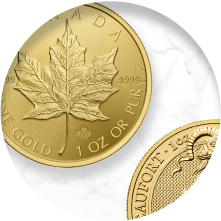
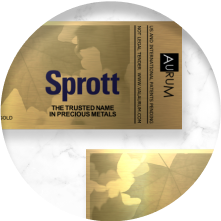

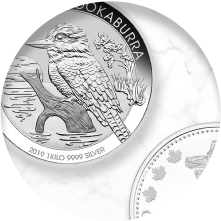
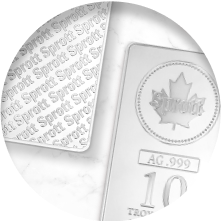

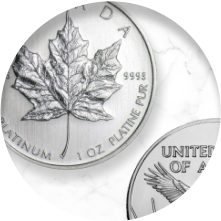

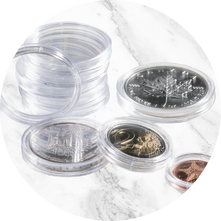
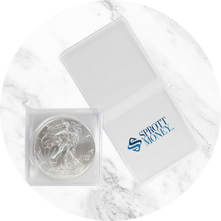


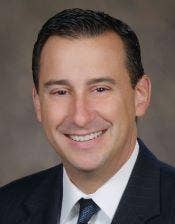
Comments